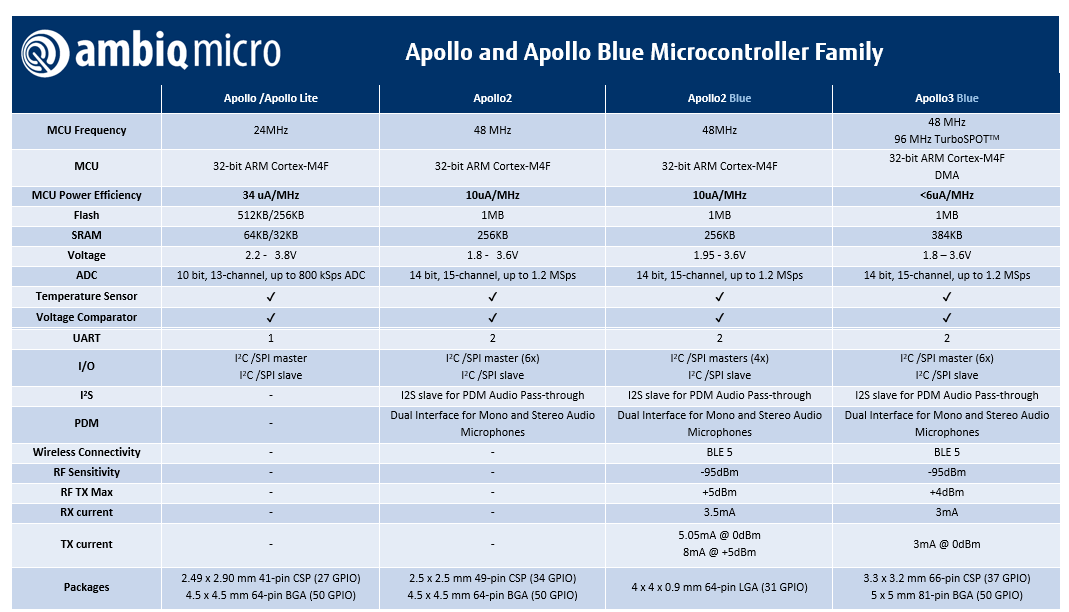Copyright © 2021 加贺富仪艾电子(上海)有限公司 版权所有 侵权必究沪ICP备2021034035号-1
技术支持:逐鹿科技 Cookie协议Introduction
At the heart of the Apollo MCUs family is Ambiq Micro’s patented Subthreshold Power Optimized Technology (SPOT™). Utilizing SPOT™ the Apollo MCUs deliver the required reduction in energy microcontrollers offer an ARM Cortex-M4F core at power levels that are even lower than competing ARM Cortex- M0+ solutions. Unrivaled power savings combined with a high-performance processing engine make the Apollo MCUs an ideal solution for battery-powered devices. With an extensive set of features to run enhanced application at an ultra-low power budget.
MCUs Selection Guide:
Apollo1
- MCUs
- EVB
Up to 24MHz clock frequency
Floating point unit
Wake-up interrupt controller with 12 interrupts
Up to 512kB Flash
Up to 64kB low-leakage RAM
10-bit, 13-channel, up to 800kSps ADC
Temperature sensor with ±4°C accuracy
I2C/SPI master for communication with external peripherals
I2C/SPI slave for optional host communications
UART for communication with peripherals and legacy devices
64-pin BGA with 50 GPIO
41-pin CSP with 27 GPIO
Apollo1 MCUs
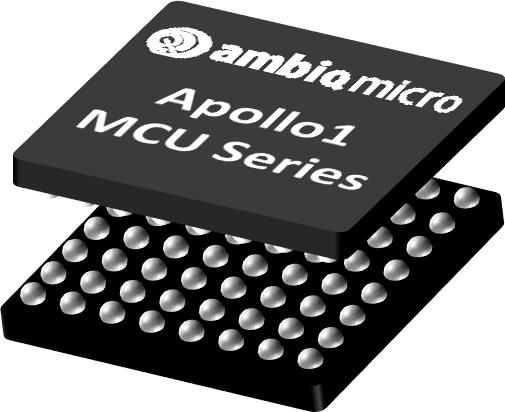
With the release of the Apollo1 MCUs Ambiq Micro proved what ultra-low power design can accomplish. Since then the growing Apollo microcontroller family provides the lowest active and sleep mode power on the market. With Apollo MCUs, designers of next generation wearables and IoT devices can take their innovative products to the next level by increasing battery life, adding more intelligent sensor processing and fitting into smaller form factors.
Available Devices:
Features
Ultra-low active mode power consumption: 34µA/MHz (executing from Flash)
Ultra-low sleep mode power consumption: 143nA (with RTC on)
High-performance, 32-bit ARM Cortex-M4F processor
Ultra-low power memory
Ultra-low power interface for off-chip sensors
Rich set of timing peripherals
Flexible serial peripherals
Wide operating range: 2.2 to 3.8V
Compact package options
USB connector / powering
Segger J-link support
Adruino shield ready
3 push buttons
4 LEDs
Quick Start Guide – Apollo1-EVB-Quick-Start-Guide-v1p0
Schematic – apollo1-apollo512-kbr-board-r1.0
Ordering Information via our Webshop
Apollo1 Evaluation Board (EVB)

The Ambiq Micro Apollo1 Evaluation Kit, or EVK, is the best place to start when designing with the Apollo 1 MCU. The EVK system contains already an on-board Segger JLINK Debugger and routes all available GPIOs to Arduino compatible headers; all designed to work together and provide you a low power, connected sensing platform.
Features:
Documents:
Apollo2
- MCUs
- EVB
<10 μA/MHz executing from flash at 3.3 V
<10 μA/MHz executing from RAM at 3.3 V
Up to 48 MHz clock frequency
Floating point unit
Memory protection unit
Wake-up interrupt controller with 32 interrupts
Up to 1 MB of flash memory for code/data
Up to 256 KB of low leakage RAM for code/data
16kB 2-way Associative Cache
14 bit, 15-channel, up to 1.2 MS/s ADC
Temperature sensor with +/-3ºC accuracy
Voltage Comparator
6x I2C/SPI master for communication with sensors, radios, and other peripherals
1x I2C/SPI slave for host communications
2x UART for communication with peripherals and legacy devices
PDM for mono and stereo audio microphones
768 kHz XTAL oscillator
Low frequency RC oscillator – 1.024 kHz
High frequency RC oscillator – 48 MHz
RTC based on Ambiq’s AM08X5/18X5 families
5 x 2.5 mm (0.35mm) 49-pin CSP with 34 GPIO
5 x 4.5 mm (0.5mm) 64-pin BGA with 50 GPIO
Apollo2 MCUs
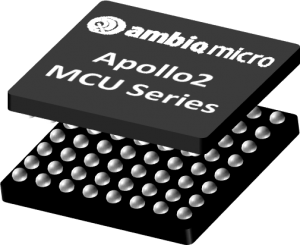
Apollo2 is the second generation into the ultra-low power Apollo microcontroller family. This highly integrated MCU reduces power consumption by more than 50% compared to the first generation Apollo MCUs, therefore empowering users with more processing capability with an even lower power budget. Apollo2 opens door for enhanced applications performing complex context detection, gesture recognition, and activity monitoring with longer battery life in wearable electronics, activity & fitness monitors, IoT devices, and wireless sensors. All Apollo series MCUs take full advantage of Ambiq Micro’s patented Subthreshold Power Optimized Technology (SPOT) Platform, setting a new industry benchmark in low power design.
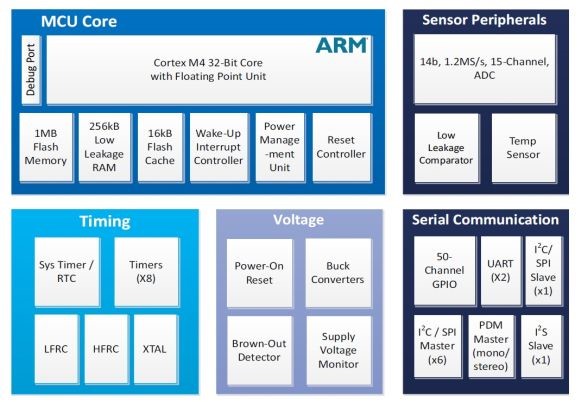
Available devices

Specifications and Features
Ultra-low supply current:
High-performance ARM Cortex-M4F Processor:
Ultra-low power memory:
Ultra-low power interface for off-chip sensors:
Flexible serial peripherals:
Rich set of clock sources:
Compact package options:
USB connector / powering
Segger J-link support
Adruino shield ready
3 push buttons
4 LEDs
Quick Start Guide – Quick-Start-Guide-for-Apollo2-EVB-Rev1p00
Ordering Information via our Webshop
Apollo2 Evaluation Board (EVB)

The Ambiq Micro Apollo2 Evaluation Kit, or EVK, is the best place to start when designing with the Apollo 2 MCU. The EVK system contains already an on-board Segger JLINK Debugger and routes all available GPIOs to Arduino compatible headers; all designed to work together and provide you a low power, connected sensing platform.
Features:
Documents:
Apollo2 Blue
- MCUs
- EVB
RF sensitivity: -95 dBm
TX: 5mA @0 dBm
RX: 3.5mA
Tx output power: -40 dBm to +5 dBm
AES 128-bit encryption
Over-The-Air updates (OTA)
Coexistence with other 2.4 GHz wireless
Bluetooth SIG profiles support
Enhanced data rate up to 2 Mbps
<10 μA/MHz executing from flash at 3.3 V
<10 μA/MHz executing from RAM at 3.3 V
< 3 μA deep sleep mode with RTC at 3.3 V
(Bluetooth in shutdown)Up to 48 MHz clock frequency
Floating point unit
Memory protection unit
Wake-up interrupt controller with 32 interrupts
Up to 31 GPIOs
Up to 1 MB of flash memory for code/data
Up to 256 KB of low leakage RAM for code/data
16kB 2-way Associative Cache
Highly configurable 14-bit ADC at 1.2 MS/s, 15 channels (7 simultaneous inputs) available
Selectable 8/10/12/14 bit precision to save energy
Voltage Comparator
Temperature sensor with +/-2ºC accuracy
4x I2C/SPI master with 128-byte bidirectional FIFO for communication with sensors, radios, and other peripheralsI
1x I2C/SPI slave for host communications with 256-byte LRAM area for FIFO/host support
2x UART modules with 32-location transmit and receive FIFOs for communication with peripherals and legacy devices
PDM audio interface support with 256-word FIFO for single or dual microphone input
RTC with both 32.768 kHz XTAL and 1.024 kHz RC sources
8x 16-bit timers with flexible functionality for timing and PWM generation
32-bit system timer with 8 compare registers for interrupt generation and 4 capture registers
768 kHz XTAL oscillator
Low frequency RC oscillator – 1.024 kHz
High frequency RC oscillator – 48 MHz
RTC based on Ambiq’s AM08X5/18X5 families
Embedded OS – FreeRTOS 9.0
ARM Cordio BLE Stack (Wicentric)
Proprietary OTA (Over the air firmware update)
Fitness Profile
Watch Profile
Standard Bluetooth SIG LE profiles
Data Exchange service
Various services supported : ANS, BAS, DIS, HRS, RSCS, TSS, PXS
Tx Power control
Concurrent Master and Slave modes
HCI over SPI 32.768 kHz XTAL oscillator
Tool Chain: IAR, Keil, GCC, Segger
Apollo2 Blue MCUs
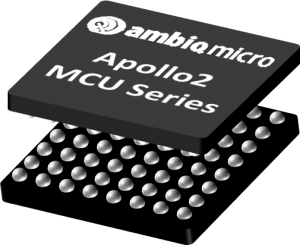
The device offers Bluetooth™ Low Energy (BLE 5) ready radio and integrates 1 MB of flash memory and 256 KB of RAM to accommodate radio and sensor overhead while leaving space for application code. This microcontroller also includes several masters and one slave SPI and I2C ports and two UART ports for communicating with sensors including accelerometers, gyroscopes, and magnetometers. Apollo2 Blue adds top rated BLE radio capability to an already existing array of relevant functionality built around the Cortex-M4 processor expressly designed for use in IoT and wearables applications.
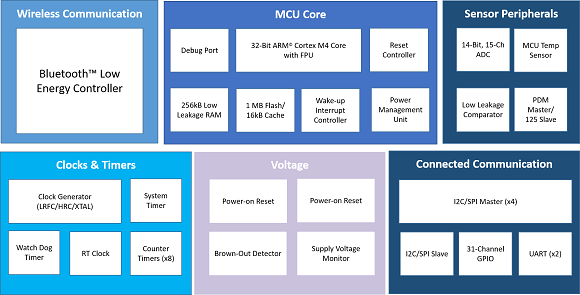
Apollo2 Blue (with BLE) device

Features
 low energy 5:
low energy 5:Built in 32 KHz RCO
Ultra-low supply current:
High-performance ARM Cortex-M4 Processor:
Ultra-low power memory:
Ultra-low power interface for off-chip sensors:
Flexible serial peripherals:
Highly configuarable timing peripherals:
Rich set of clock sources:
Wide operating range: 1.755 – 3.60 V, –40 to 85°C
Compact package: 4 x 4 x 0.9 mm 64-pin LGA
Software Support:
USB connector / powering
Segger J-link support
Adruino shield ready
3 push buttons
4 LEDs
Quick Start Guide –Apollo2-Blue-EVB-rev0_3-Quick-Start-Guide-r1p0
Ordering Information via our Webshop
Apollo2 Blue Evaluation Board
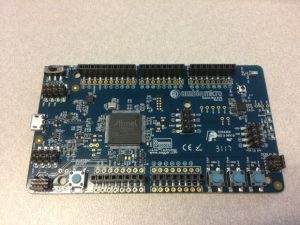
The Ambiq Micro Apollo2 Blue Evaluation Kit, or EVK, is the best place to start when designing with the Apollo2 Blue MCU. The EVK system contains already an on-board Segger JLINK Debugger and routes all available GPIOs to Arduino compatible headers; all designed to work together and provide you a low power, connected sensing platform.
Features:
Documents
Apollo3 Blue
- MCUs
6 μA/MHz executing from flash at 3.3 V
6 μA/MHz executing from RAM at 3.3 V
1 μA deep sleep mode (BLE Off) with RTC at 3.3 V
48 MHz nominal clock frequency, with 96 MHz high performance
Floating point unit
Memory protection unit
Wake-up interrupt controller with 32 interrupts
RF sensitivity: -93 dBm (typical)
TX: 3 mA @ 0 dBm, RX: 3 mA
Tx peak output power: 4.0 dBm (max)
Up to 1 MB of flash memory for code/data
Up to 384 KB of low leakage RAM for code/data
16 kB 2-way Associative/Direct-Mapped Cache
14 bit ADC at up to 1.2 MS/s, 15 selectable input channels available
Voltage Comparator
Temperature sensor with ±3°C accuracy
1x 2/4/8-bit SPI master interface
6x I2C/SPI masters for peripheral communication
I2C/SPI slave for host communications
2x UART modules with 32-location Tx and Rx FIFOs
PDM for mono and stereo audio microphone
1x I2S slave for PDM audio pass-through
768 kHz XTAL oscillator
Low frequency RC oscillator – 1.024 kHz
High frequency RC oscillator – 48/96 MHz
RTC based on Ambiq’s AM08X5/18X5 families
37 x 3.25 mm(<0.35mm thk pkg) 66-pin CSP with 37 GPIO
5 x 5 mm (<0.5mm thk pkg) 81-pin BGA with 50 GPIO
Apollo3 Blue MCUs
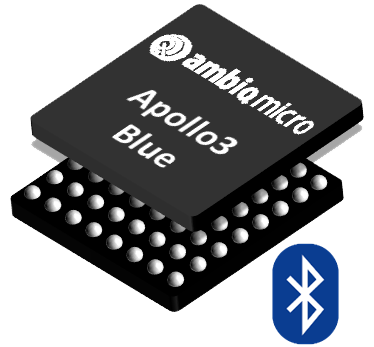
Apollo3 Blue is the upcoming new MCUs expanding the ultra-low power Apollo microcontroller family. It manages a further reduction in power consumption compared to the so far unprecedented values of the former Apollo generations. At the heart of the Apollo3 Blue MCU is Ambiq Micro’s patented Subthreshold Power Optimized Technology (SPOT™) and a powerful ARM Cortex-M4 processor with Floating Point Unit. With its extended set of features and incorporated BLE 5, the Apollo3 Blue enables users to run sophisticated processes in hearables, wearables, IoT edge devices and voice controlled applications within an ultra-competitive power budget.
Currently available in beta stage for selected customers, the Apollo3 Blue is ready for mass production in Q1/19. First evaluation samples of the 81-pin BGA package and Evaluation-Kits are available upon request.
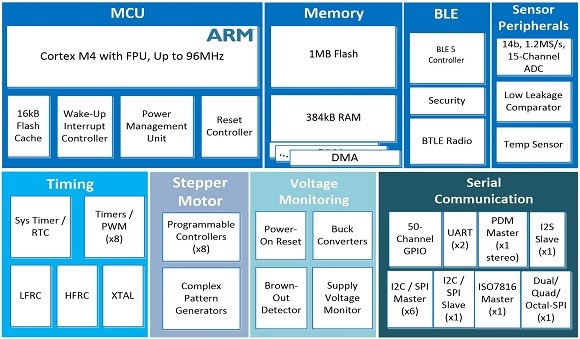
Specifications and Features
Ultra-low supply current:
High-performance ARM Cortex-M4Processor
Burst Mode
Integrated Bluetooth 5 low-energy module
Ultra-low power memory:
Ultra-low power interface for off-chip sensors:
ISO7816 Secure interface
Flexible serial peripherals:
Rich set of clock sources:
Wide operating range: 1.755-3.63 V, –40 to 85°C
Compact package option:
Technology
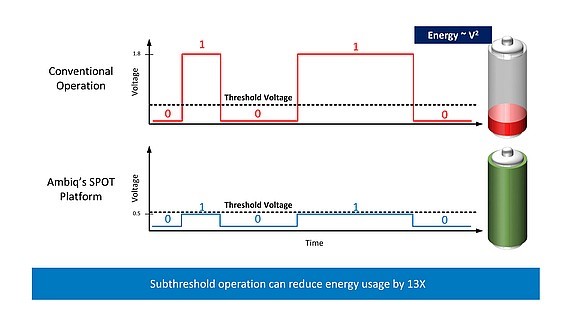
 ) platform. The patented SPOT
) platform. The patented SPOT architecture uses transistors biased in the subthreshold region of operation (aka very low voltages) to achieve unmatched energy efficiency.
architecture uses transistors biased in the subthreshold region of operation (aka very low voltages) to achieve unmatched energy efficiency.Breakthrough subthreshold design
Operation at such low voltages is problematic due to susceptibility to noise, high sensitivity to temperature, and variability due to process drift. In developing the SPOT
 platform, Ambiq Micro has addressed all of these challenges by redesigning every analog and digital circuit in the chip to adapt for the temperature, voltage, and manufacturing variations that are problematic at these voltage levels.
platform, Ambiq Micro has addressed all of these challenges by redesigning every analog and digital circuit in the chip to adapt for the temperature, voltage, and manufacturing variations that are problematic at these voltage levels.Implemented in Standard CMOS
 platform, Ambiq Micro’s products behave just like any other semiconductor device and they are implemented using industry-standard CMOS manufacturing flows. The one difference: dramatically reduced power consumption.
platform, Ambiq Micro’s products behave just like any other semiconductor device and they are implemented using industry-standard CMOS manufacturing flows. The one difference: dramatically reduced power consumption. Applications
Consumer medical devices
Consumer electronics
Smart watches
Smart meters
Battery-powered applications
Wearable electronics
Wireless sensors
Activity and fitness monitors
Beacons
Remote sensing
Motion and tracking devices
Home automation
Light control applications
Wireless mice and keyboards
Alarms and security system
Toys
MCUs Applications
Supplier Profile
Company Overview

Ambiq Micro was founded in 2010 on the notion that extremely low power semiconductors are the key to the future of electronics. They developed a patented Subthreshold Power Optimized Technology (SPOT™) platform that dramatically reduces the amount of power consumed by semiconductors.Normal CMOS processes are working with an internal core voltage above the threshold voltage a transistor needs to make a logical low or high decision. Therefore most cores are working at 1.8V or 1.2V depending on the CMOS process.
By applying SPOT™on a standard CMOS process, the internal core voltage can be minimized to 0.5V. While the energy consumption is proportional to the squared voltage, SPOT™ can reduce energy usage by up to 13 times!



